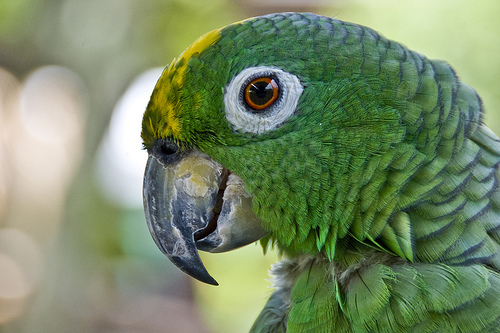
What is bumblefoot?
Bumblefoot (Pododermatitis) is a common affliction of captive birds. It is the inflammatory or degenerative condition of the weight-bearing surface of the foot.
Which species of birds are susceptible to bumblefoot?
Bumblefoot occurs in all species of birds. However, it is primarily a problem of captive birds. Obese and inactive birds are particularly prone to developing bumblefoot. Pet birds typically get bumblefoot because there is an underlying problem with some aspect of their husbandry. It is necessary to identify and correct the underlying problem in order to prevent the problem from recurring.
How can I recognize if my bird has bumblefoot?
The symptoms of bumblefoot may not be initially apparent to some owners. Lameness is usually the first sign to be noticed – the bird may appear unwilling to land, stand, or grasp normally with one or both of its feet. Examination of the feet may show mild signs, such as a slight reddening of the skin around the feet and a loss of the normal scale.
Cracked or traumatized skin is susceptible to bacterial colonization, which can lead to abscess formation. In more severe cases, there can be as ulcer formation on the pads of the feet, chronic abscessation, and infection of the bones of the feet. Once infection spreads to the bones and joints, birds become severely lame, and surgery is required if there is to be any chance of recovery.
What are the causes of bumblefoot?
There are usually a number of contributing factors in a case of bumblefoot, such as:
• Inappropriate perches – perches that are of uniform size and made of improper materials (e.g. hard plastic or covered with sandpaper) are detrimental to birds’ feet
• Poor hygiene – if perches are infrequently cleaned, bacteria can accumulate and spread to a foot that has already been damaged and lost its protective scales
• Poor nutrition – fatty diets, a dietary deficiency of vitamin A, and diets that are high in cholesterol and low in calcium (e.g. day old chicks) are all associated with bumblefoot
• Obesity and inactivity
• Compromised immune function – birds that have concurrent illnesses will be more susceptible to disease
How is bumblefoot diagnosed?
If you suspect your bird is suffering from bumblefoot, consult an avian veterinarian. The history of lameness, combined with obvious redness and swelling of the feet are clear indicators of bumblefoot.
However, x-rays of the feet are usually required to determine the extent of the infection. X-rays will indicate if the infection has spread to the bones of the feet, a condition that carries a grave prognosis.
How is bumblefoot treated?
The first priority is to correct any underlying problems in the husbandry and/or diet.
• Provide different perch sizes and types, as well as a variety of substrates – natural branches of different sizes make good perches because the bird’s feet are not held in the same position all the time
• Soften perches by wrapping bandages or strips of clothe around them
• Improve cage hygiene
• Ispagula husk (e.g. Isogel, Regulan, Metamucil) may lower cholesterol levels in birds fed fatty food (this is useful in parrots)
• For raptors, consider feeding rodents or day-old chicks that have had their yolk sacs removed
• Consumption of vitamin A can be increased by adding more dark green vegetables to the diet, adding a vitamin A supplement, or changing to a complete pelleted diet
In terms of medical treatment:
• Moderate cases (i.e. cases with redness of the skin and minimal swelling) should have an antibiotic ointment applied at least twice a day to the affected feet
• Oral antibiotics are also recommended to control infection systemically
• A blood sample is useful for detecting any other health problems that may be affecting the birds immune system
• Ball bandages are used relieve pressure on the foot and to allow the bird to stand comfortably – bandages need to be changed regularly
• A swab should be taken from the sight of infection and sent to a lab for a culture and sensitivity test. A culture and sensitivity test determines which bacteria are present, and the antibiotics that can be used to treat the bacteria
• Severe cases often necessitate surgery to remove plugs of inspissated pus and necrotic (dead) tissue – this may require amputation of a toe
While very mild cases can clear up within a few days, severe cases of bumblefoot can take weeks to months to resolve, and the bird may be left with permanent damage to its feet. The sooner treatment is initiated, the better the prognosis for recovery will be.
How can I prevent my bird from getting bumblefoot?
Preventing bumblefoot depends on providing your bird with proper husbandry: good sanitation, a balanced diet, and appropriate perches will help reduce the incidence of bumblefoot. Regular visits to a veterinarian will also ensure that any signs of bumblefoot are quickly identified and treated.
(photo: nsaplayer)